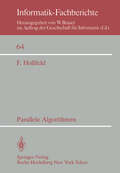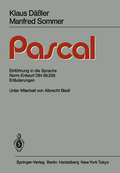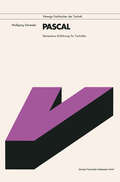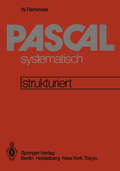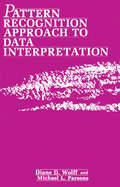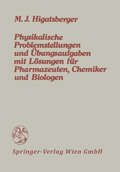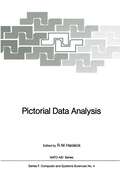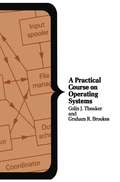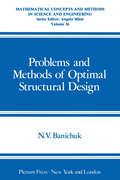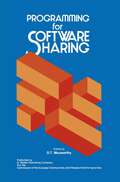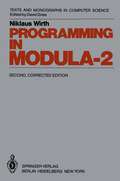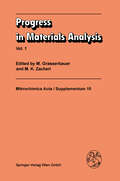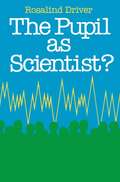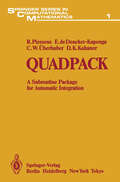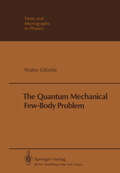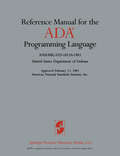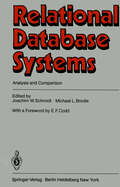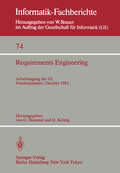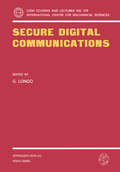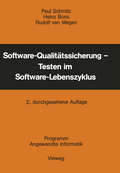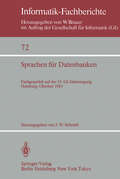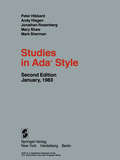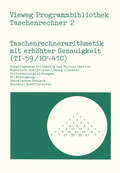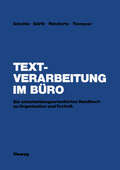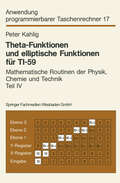- Table View
- List View
Parallele Algorithmen (Informatik-Fachberichte #64)
by F. HossfeldZu den allgemeinen Einordnungen von Algorithmen ist in den letzten Jahren eine neue Klassifikation wichtig geworden: parallel versus sequentiell. Die Ursache findet sich in der nicht zuletzt durch die Entwicklungen der Halbleitertechnologie, vor allem aber durch den wachsenden Druck von Anwendungen, die höchste Rechnerleistung erfordern, erhöhten Bedeutung von Parallelprozessorarchitekturen. Das zunehmende Interesse an Parallelrechnern hat die Entwick lung von parallelen Algorithmen zur Lösung vielfältiger Problemstellungen beschleunigt. Eine Darstellung von Grundprinzipien, Entwurfsmöglichkeiten und Realisierungen paralleler Algorith men, die das Leistungspotential innovativer Rechnerarchitekturen erschließen, erscheint für die integrale Betrachtung der Thematik des "Parallel Computing" nicht nur notwendig, sondern auch - vor allem auf die deutschsprachige Fachliteratur bezogen - überfällig. Dem vorliegenden Band liegt das Skriptum -einer Spezial vorlesung gleichen Titels zugrunde, die ich im Sommersemester 1980 an der Universität Dortmund auf Einladung der Abteilung Informatik gehalten habe. Es ist nicht das Ziel, eine möglichst vollständige Sammlung der in den Zweigen dieses expansiven Forschungsgebietes bisher entwickelten parallelen Algorithmen zu liefern; vielmehr sollen mit dieser Annäherung an eine erste Gesamtdarstellung der Themati- insbesondere auch durch die Gegenüberstellung von repräsentativen sequentiellen Algorithmen - Charakteristika originärer paralleler Algorithmen aufgezeigt und ihr Bezug zu den Architektur elementen von Parallelprozessoren verdeutlicht werden. Dadurch soll auch hierzulande das Interesse an dieser immer wichtiger werdenden Fragestellung weiter gefördert und der Einstieg in die junge, über ein breites Spektrum von hauptsächlich englischsprachigen Fachzeitschriften verstreute Originalliteratur erleichtert werden; wegen der angelsächsischen Dominanz auf diesem Gebiet lassen sich dabei für die klare Begriffsbestimmung naturgemäß gewisse Anglizismen nicht vermeiden.
Pattern Recognition Approach to Data Interpretation
by Diane WolffAn attempt is made in this book to give scientists a detailed working knowledge of the powerful mathematical tools available to aid in data interpretation, especially when con fronted with large data sets incorporating many parameters. A minimal amount of com puter knowledge is necessary for successful applications, and we have tried conscien tiously to provide this in the appropriate sections and references. Scientific data are now being produced at rates not believed possible ten years ago. A major goal in any sci entific investigation should be to obtain a critical evaluation of the data generated in a set of experiments in order to extract whatever useful scientific information may be present. Very often, the large number of measurements present in the data set does not make this an easy task. The goals of this book are thus fourfold. The first is to create a useful reference on the applications of these statistical pattern recognition methods to the sciences. The majority of our discussions center around the fields of chemistry, geology, environmen tal sciences, physics, and the biological and medical sciences. In Chapter IV a section is devoted to each of these fields. Since the applications of pattern recognition tech niques are essentially unlimited, restricted only by the outer limitations of.
Physikalische Problemstellungen und Übungsaufgaben mit Lösungen für Pharmazeuten, Chemiker und Biologen
by Michael J. HigatsbergerPictorial Data Analysis (NATO ASI Subseries F: #4)
by Robert M. HaralickThis volume is the collection of lectures and presentations of the NATO AS! On Pictorial Data Analysis, held August 1-12, 1982 in the beautiful chateau de Bonas, Bonas France. The director of the AS! was Robert M. Haralick and the Co-director was Stefano Levialdi. The papers in the book are arranged in two sections first theory and general prinicples and then applications. Local computations play a central role in image processing both when a traditional computer is used and when parallel machines are used for improving image throughput. Levialdi reviews such neighborhood operators. Hung and Kasvand discuss a line thinning application which involves detection of critical points on chain encoded data. Most low level image processing has been done using the digital raster as the basic data structure. Within the last few years many of these basic algorithms have been developed for the quadtree data structure. The quadtree permits easier access to certain kinds of spatial adjacency relationships in a variable resolution context. Rosenfeld reviews the properties of these representations and their uses in image segmentation and property measurement. Besslich discusses an expanded form of an invertible quadtree representation which permits a multiprocessor execution. Gisolfi and Vitulano discuss the C-matrix and C-filtering technique for image and texture feature extraction. O'mara et.al. discuss the application of Codel numbers to image feature extraction. Kropatsch discusses an image segmentation technique which permits the effective use of a variety of different kinds of segmentation techniques.
Problems and Methods of Optimal Structural Design (Mathematical Concepts and Methods in Science and Engineering #26)
by Nikolai Vladimirovich BanichukThe author offers a systematic and careful development of many aspects of structural optimization, particularly for beams and plates. Some of the results are new and some have appeared only in specialized Soviet journals, or as pro ceedings of conferences, and are not easily accessible to Western engineers and mathematicians. Some aspects of the theory presented here, such as optimiza tion of anisotropic properties of elastic structural elements, have not been con sidered to any extent by Western research engineers. The author's treatment is "classical", i.e., employing classical analysis. Classical calculus of variations, the complex variables approach, and the Kolosov Muskhelishvili theory are the basic techniques used. He derives many results that are of interest to practical structural engineers, such as optimum designs of structural elements submerged in a flowing fluid (which is of obvious interest in aircraft design, in ship building, in designing turbines, etc.). Optimization with incomplete information concerning the loads (which is the case in a great majority of practical design considerations) is treated thoroughly. For example, one can only estimate the weight of the traffic on a bridge, the wind load, the additional loads if a river floods, or possible earthquake loads.
Programming for Software Sharing (Ispra Courses)
by D. T. MuxworthyMost computer users are familiar with the problems of sharing software with others, and the transfer of programs from one computing environment to another. Software represents an ever-increasing proportion of the cost of computing and these costs tend to nullify all the economic advantages flowing from the wider availability of cheap hardware. Years ago it was hoped that the widespread use of high-level programming languages would help in alleviating the problems of software production, by increasing productivity and by making it simpler for users with similar problems to be able to use the same programs, possibly on different types of machines. It is a common experience that in practice this simple optimism has proved to be unfounded. It was these considerations which led us in 1979 to organize a two-week course on "Programming for Software Sharing" at the European Community Joint Research Centre, Ispra Establishment (Italy), forming part of the regular series of "Ispra Courses". With prominent invited lecturers, local contributions and through discussion sessions we examined with an audience from many countries the problems involved in the sharing and transfer of software, as well as suggesting ways of overcoming them. In our local environment we are faced daily with three problems both from engagements in software exchange in the scientific-technical field on a Europe-wide or world-wide basis, and from work with programming techniques and contributions to the international standardization process.
Programming in Modula-2 (Monographs in Computer Science)
by N. WirthThis text is an introduction to programming in general, and a manual for programming with the language Modula-2 in particular. It is oriented primarily towards people who have already acquired some basic knowledge of programming and would like to deepen their understanding in a more structured way. Nevertheless, an introductory chapter is included for the benefit of the beginner, displaying in a concise form some of the fundamental concepts of computers and their programming. The text is therefore also suitable as a self-contained tutorial. The notation used is Modula-2, which lends itself well for a structured approach and leads the student to a working style that has generally become known under the title of structured programming. As a manual for programming in Modula-2, the text covers practically all facilities of that language. Part 1 covers the basic notions of the variable, expression, assignment, conditional and repetitive statement, and array data structure. Together with Part 2 which introduces the important concept of the procedure or subroutine, it contains essentially the material commonly discussed in introductory programming courses. Part 3 concerns data types and structures and constitutes the essence of an advanced course on programming. Part 4 introduces the notion of the module, a concept that is fundamental to the design of larger programmed systems and to programming as team work. The most commonly used utility programs for input and output are presented as examples of modules. And finally, Part 5 covers facilities for system programming, device handling, and multiprogramming.
Progress in Materials Analysis: Vol. 1 (Mikrochimica Acta Supplementa #10)
by M. Grasserbauer M. K. ZacherlThe 11th Colloquium on Metallurgical Analysis - a joint venture of the Institute of Analytical Chemistry of the Technical University in Vienna, the Austrian Society for Analytical Chemistry and Microchemistry, the German Metals Society (DGM), and the Society of German Iron and Steel Engineers (VDEh) - was attended by 120 scientists from 12 nations. The major topics covered were surface, micro and trace analysis of materials with a heavy emphasis on metals. According to the strategy of the meeting attention was focussed on an interdisciplinary approach to materials science - combining analytical chemistry, solid state physics and tech nology. Therefore progress reports on analytical techniques (like SIMS, SNMS, Positron Annihilation Spectroscopy, AES, XPS) were given as well as pre sentations on the development of materials (like for the fusion reactor). The majority of the discussion papers centered on the treatment of important technical problems in materials science and technology by a (mostly sophis ticated) combination of physical and chemical analytical techniques. The intensive exchange of ideas and results between the scientists oriented towards basic research and the industrial materials technologists was very fruitful and resulted in the establishment of several scientific cooperations. Major trends in materials analysis were also dealt with in a plenary discussion of which a short summary is contained in this volume. In order to facilitate international communication in the field of materials analysis and in view of the important questions treated in the various contri butions this proceedings volume was edited in English.
Pupil As Scientist (UK Higher Education OUP Humanities & Social Sciences Education OUP)
by Rosalind DriverThe Pupil as Scientist intends to give teachers and student teachers a better understanding of the thinking of young adolescent pupils in science lessons and to indicate the difficulties such pupils have in understanding the more abstract or formal ideas with which they are presented. It is practical in its orientation as the issues discussed are illustrated with examples drawn from dialogue and observations made in science classes.One of Rosalind Driver's main themes is that science teachers must recognise more fully and act upon the preconceptions and alternative frameworks which pupils bring to their study of science.Despite is practical orientation, the book addresses some fundamental questions arguing for a reappraisal of science teaching in secondary schools in the light of developments in cognitive psychology and philosophy of science.This is an accessible, authoritative and very helpful book for all concerned with the teaching of science in the secondary years.
Quadpack: A Subroutine Package for Automatic Integration (Springer Series in Computational Mathematics #1)
by R. Piessens E. de Doncker-Kapenga C.W. Überhuber D.K. Kahaner1. 1. Overview of Numerical Quadrature The numerical evaluation of integrals is one of the oldest problems in mathematics. One can trace its roots back at least to Archimedes. The task is to compute the value of the definite integral of a given function. This is the area under a curve in one dimension or a volume in several dimensions. In addition to being a problem of great practi cal interest it has also lead to the development of mathematics of much beauty and insight. Many portions of approximation theory are directly applicable to integration and results from areas as diverse as orthogo nal polynomials, Fourier series and number theory have had important implications for the evaluation of integrals. We denote the problem addressed here as numerical integration or numerical quadrature. Over the years analysts and engineers have contributed to a growing body of theorems, algorithms and lately, programs, for the solution of this specific problem. Much effort has been devoted to techniques for the analytic evalua tion of integrals. However, most routine integrals in practical scien tific work are incapable of being evaluated in closed form. Even if an expression can be derived for the value of an integral, often this reveals itself only after inordinate amounts of error prone algebraic manipulation. Recently some computer procedures have been developed which can perform analytic integration when it is possible.
The Quantum Mechanical Few-Body Problem (Theoretical and Mathematical Physics)
by W. GlöckleFew-body systems are both technically relatively simple and physically non trivial enough to test theories quantitatively. For instance the He-atom played historically an important role in verifying predictions of QED. A similar role is contributed nowadays to the three-nucleon system as a testing ground far nuclear dynamics and maybe in the near future to few-quark systems. They are also often the basic building blocks for many-body systems like to some extent nuclei, where the real many-body aspect is not the dominant feature. The presentation of the subject given here is based on lectures held at var ious places in the last ten years. The selection of the topics is certainly subjec tive and influenced by my own research interests. The content of the book is simply organized according to the increasing nu mb er of particles treated. Be cause of its conceptual simplicity single particle motion is very suitable for in troducing the basic elements of scattering theory. Using these elements the two-body system is treated for the specific case of two nucleons, which is of great importance in the study of the nuclear interaction. Great space is devoted to the less trivial few-body system consisting of three particles. Again physical examples are taken solely from nuclear physics. Finally the four particle system is discussed so as to familiarize the reader with the techniques required for the formulations of n-bodies in general.
Relational Database Systems: Analysis and Comparison
by Joachim W. Schmidt Michael L. BrodieAfter a long period of research, development, test and trial, relational database management systems are at last being marketed in force. The feedback from early installations of these systems is overwhelmingly positive. The most frequent comment by users is that productivity has been increased by a significant factor (from 5 to 20 times what it was using previous approaches). Another comment is that, in many cases, end users can now handle their own problems by direct use of the system instead of using application programmers as mediators between them and the system. As the reputation of relational systems for ease of use and enhanced productivity has grown, there has been a strong temptation for vendors of other approaches to exploit the label "relational" somewhat indiscriminately. In some cases the label is being misapplied to a whole data system; in others it is being misapplied to an interface. It is therefore worth developing criteria which database management systems (DBMSs) should have in order to be called "relational". The Relational Task Group (RTG) of the American National Standards Institute (ANSI) undertook such an effort by developing a characterization of RDBMSs and analyzing fourteen DBMSs per this characterization. The result of this work is presented in this book. The conclusions of the RTG are in agreement with my view that a DBMS should not be called "relational" unless it satisfies at least the following conditions: 1. All information in the database is represented as values in tables.
Requirements Engineering: Arbeitstagung der GI, Friedrichshafen, 12–14 Oktober 1983 (Informatik-Fachberichte #74)
by G. Hommel D. KrönigDie Arbeitstagung "Requirements Engineering für die Automatisierung von Systemen" wird vom Fachausschuß 4.3 "Requirements Engineering" der Gesellschaft für Informatik in Zusammenarbeit mit der Fachgruppe 4.4.1 "Systematisches Entwerfen von PDV-Systemen", einer gemeinsamen Fach gruppe von GI und VDI/VDE-GMR, und mit dem Fachausschuß 4.2 "Rechner gestütztes Entwerfen und Projektieren (CAE)" veranstaltet. Unter Requirements Engineering wird hier die ingenieurmäßige Ermitt lung der Anforderungen an die Automatisierung eines Systems und ihrer Aufarbeitung zur Realisierung in Hardware und Software verstanden. Es ist das erste Mal im deutschsprachigen Raum, daß speziell zu die sem Thema eine Tagung veranstaltet wird. Dies scheint gerechtfertigt durch das international zunehmende Interesse an dieser Problematik, welches offensichtlich aus den erheblichen Schwierigkeiten resultiert, die in der Praxis bei der Bewältigung dieser Aufgabe auftreten. Die Aufgabe wird häufig mit projektbezogenen Verfahren angegangen. Andererseits gibt es aber bereits theoretische Methoden zur systema tischen Anforderungserschließung, deren Einsatz in der industriellen Praxis jedoch noch Schwierigkeiten bereitet. In dieser Situation will die Arbeitstagung den Erfahrungsaustausch zwischen Theorie und Praxis fördern. Der Programmausschuß hat sich bemüht, unter den Vortragsan meldungen die Auswahl so zu treffen, daß einerseits der Stand der Tech nik und die vorliegenden Erfahrungen und andererseits Ansätze für zu künftige Entwicklungen in diesem Bereich erkennbar sind.
Software-Qualitätssicherung — Testen im Software-Lebenszyklus (Programm Angewandte Informatik)
by Paul SchmitzSprachen für Datenbanken: Fachgespräch auf der 13. GI-Jahrestagung Hamburg, 3. – 7. Oktober, 1983 (Informatik-Fachberichte #72)
by J. W. SchmidtTaschenrechnerarithmetik mit erhöhter Genauigkeit (Vieweg Programmbibliothek Taschenrechner #2)
by Peter G. PoloczekTextverarbeitung im Büro: Ein entscheidungsorientiertes Handbuch zu Organisation und Technik
by Erwin GrochlaTheta-Funktionen und elliptische Funktionen für TI-59: Mathematische Routinen der Physik, Chemie und Technik Teil IV (Anwendung programmierbarer Taschenrechner #17)
by Peter KahligDie speziellen Funktionen, insbesondere die elliptischen Funktionen, hatten in Physik und Technik stets ungeheure Bedeutung und wurden in den Vorlesungen der Hochschulen im 19. und be ginnenden 20. Jahrhundert entsprechend berücksichtigt. Später sind die speziellen Funktionen aus den Vorlesungen verschwunden, und es traten die strukturellen Gesichtspunkte der Mathematik in den Vordergrund. Dies hat zu einer gewissen Entfremdung zwischen Anwendungen und theoretischer Ausbildung im Vorlesungsbetrieb geführt. Allerdings haben im angelsächsischen Sprachraum die speziellen Funktionen stets durch Bücher und Tafelwerke Berücksichtigung gefunden, entsprechend ihrer Bedeutung sowohl für Anwendungen der Mathematik wie auch für theoretische Begriffsbildungen. Durch den Computer (bzw. seinen kleinen Bruder, den Taschenrechner) ist die Freude am numerischen Rechnen ganz bedeutend gestiegen. Wegen erhöhter Genauigkeitsansprüche in Physik· und Technik kann man sich heute nicht mehr mit linearen Näherungen begnügen (berühmtes Beispiel: das Pendel); dadurch braucht auch der Ingenieur und Physiker die speziellen Funktionen, im besonderen die elliptischen Funktionen. Es ist zu begrüßen, daß der Autor P. Kahlig, von dem schon analoge Veröffentlichungen vorliegen, einen Band über die elliptischen Funktionen und die Theta-Funktionen herausbringt, deren Bedeutung auch für die Wärmeleitung und Diffusion ja wohlbekannt ist. Genaue Funktionswerte sind somit jedem Anwender schnell und leicht zugänglich. Es ist diesem Band weite Verbreitung zu wünschen. Univ. Prof. Dr. Dr. h.c. Edmund Hlawka, Institut für Analysis, Technische Mathematik und Versicherungs mathematik der Technischen Universität sowie Institut für Mathematik der Universität Wien. Wirkl. Mitglied der Österr. Akademie der Wissenschaften, Mitglied der Deutschen Akademie der Naturforscher, korrespond.
